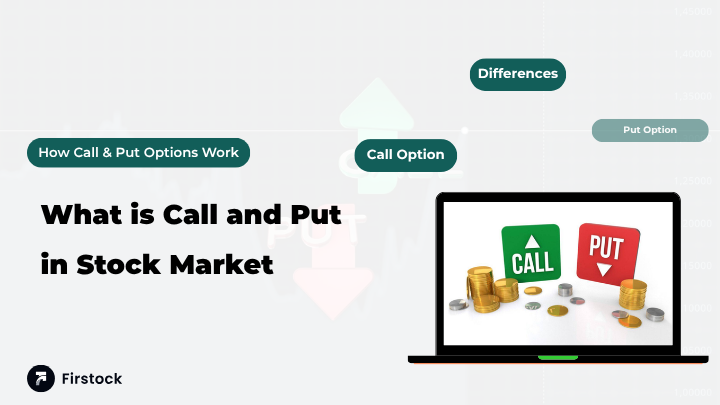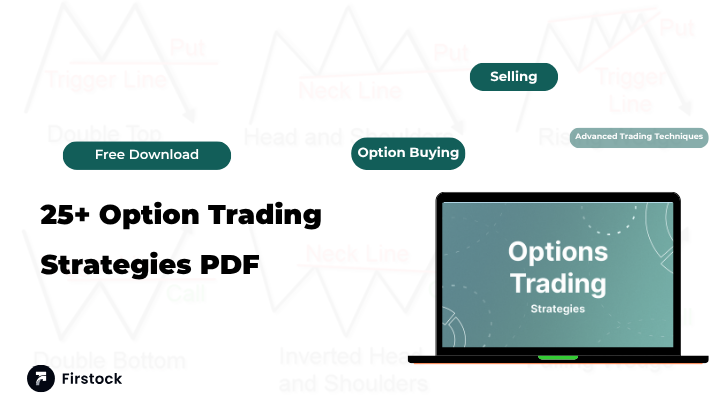What is Call and Put in Stock Market (2026) | Beginner’s Guide

What is Call and Put: A Beginner’s Guide to Options Trading (Explained with Examples)
Understanding what is call and put might sound intimidating at first, but once you get the hang of it, it’s like learning the rules of a simple game. Whether you’re a beginner in stock trading or just curious about how traders make money even when prices fall, this guide will make everything clear — with real-life call and put options examples, easy analogies, and practical insights.
And if you want to practice trading options without risk, Firstock (a smart stock trading app) is a great place to start — it helps you trade confidently with real-time data and analytical tools built for both beginners and professionals.
Introduction: Understanding the Basics of Options
Have you ever wished you could predict a stock’s price movement and make a profit without actually buying it? That’s the power of options trading. In the world of finance, call and put options are like buying a ticket to a possibility.
A call option entitles you to purchase something in future at a predetermined price whereas a put option entitles you to sell. It is as if you are making a movie ticket reservation, you are simply making your reservation without necessarily making a promise.
What Are Options in the Stock Market?
Options are financial contracts that give the buyer the right but not the obligation to buy or sell a stock at a certain price within a set period.
There are two main types:
- Call Option – Right to buy.
- Put Option – Right to sell.
You can think of options as insurance against market moves — traders use them to protect profits or bet on future price changes.
What is Call and Put - Explained
What Is a Call Option?
A call option is a contract that gives you the right to buy a stock at a specific price (called the strike price) before a certain date (called the expiry date).
- If you expect a stock to rise, you buy a call option.
- If the stock price increases above your strike price, you make a profit.
Example: Suppose you buy a call option for Reliance at ₹2,500 strike price, paying ₹50 as a premium. If Reliance’s price rises to ₹2,600, you can buy it at ₹2,500 and instantly gain ₹100 profit (minus premium).
What Is a Put Option?
A put option gives you the right to sell a stock at a specific price before a certain date.
- If you expect the stock to fall, you buy a put option.
- You profit when the stock’s price goes below the strike price.
Example: You buy a put option for TCS at ₹3,500 strike price with a ₹40 premium. If TCS falls to ₹3,300, you can sell at ₹3,500 and make ₹200 profit (minus premium).
Difference Between Call Option and Put Option
How Do Call and Put Options Work?
Let’s simplify it further:
Imagine you’re at a shopping mall. You see a limited-edition phone priced at ₹50,000. You pay ₹1,000 to reserve the right to buy it at this price within a month.
- If the price rises to ₹55,000, you buy it for ₹50,000 — great deal! (This is a call option)
- If the price falls to ₹45,000, you simply walk away, losing only ₹1,000.
That ₹1,000 you paid is your premium — just like in the options market.
Real-Life Call Option Example
Let’s take a practical case:
You believe Infosys stock, currently at ₹1,600, will rise. You buy a call option with a ₹1,650 strike price for ₹20 premium.
- If Infosys rises to ₹1,700, your profit is ₹50 (₹1,700 - ₹1,650) minus ₹20 = ₹30 per share.
- If it stays below ₹1,650, you lose only ₹20.
That’s the beauty of Call Option Buying.
Real-Life Put Option Example
Now, you think HDFC Bank, currently ₹1,700, will fall. You buy a put option with a ₹1,650 strike price for ₹25 premium.
- If HDFC drops to ₹1,600, your profit = ₹50 - ₹25 = ₹25 per share.
- If it rises instead, your maximum loss is ₹25.
That’s why investors often use Put Option buying as protection during market uncertainty.
Why Do Traders Use Call and Put Options?
Options are used for three main reasons:
- Speculation: To profit from price movements.
- Hedging: To protect investments from losses.
- Income Generation: Through strategies like covered calls.
Smart traders use discount broker like Firstock to track live options data, analyze market trends, and make decisions based on real-time insights.
Advantages of Call and Put Options
Here are some big reasons why traders love options:
- Low Investment: You control large positions with small premiums.
- Flexibility: You can profit in both rising and falling markets.
- Hedging Tool: Protect your portfolio from sudden market crashes.
- Leverage: Amplify profits with limited risk.
Platforms like Firstock make it easy to trade and manage all this from one place — perfect for both learners and pros.
Risks Involved in Options Trading
While options offer great opportunities, they come with certain risks:
- Premium Loss: If the stock doesn’t move as expected, you lose the premium.
- Time Decay: Options lose value as expiry nears.
- Complex Strategies: Without understanding, you can make poor decisions.
That’s why it’s crucial to learn first — and Firstock provides built-in analytics and virtual trading tools to help you practice safely before investing real money.
How to Start Trading Options on Firstock
Starting with Firstock is easy:
- Sign up on the platform.
- Choose Options Trading Dashboard.
- Analyze live market data using in-built scanners.
- Practice with simulated trades to understand call and put dynamics.
- Trade Live once you’re confident.
It’s user-friendly, fast, and designed for every kind of trader — from curious beginners to active investors.
Common Mistakes Beginners Make in Options Trading
Avoid these beginner traps:
- Trading without understanding strike prices.
- Ignoring time decay (expiry impact).
- Putting all money into one trade.
- Not tracking volatility.
- Forgetting to use stop-loss or exit plans.
Platforms like Firstock provide data insights to help you avoid these mistakes.
Expert Tips to Trade Options Wisely
Here are some pro tips from experienced traders:
- Start small – trade with low premiums first.
- Use stop-loss orders.
- Learn technical analysis to identify trends.
- Use tools like Firstock for real-time analysis.
- Keep emotions in check – don’t chase losses.
Remember: In trading, patience and discipline are your best friends.
Conclusion:
Understanding what is call and put is your first step into the exciting world of options trading. These tools let you profit in any market — up or down — if you know how to use them wisely.
And to make the journey smoother, Firstock is the perfect companion. The most powerful analytics and options chain insights are combined with a user-friendly interface, which allows you to trade smarter, safer, and faster.
Therefore, the next time a person decides to inquire about what a call or a put option is, you will know and perhaps have a trade to be made!
FAQs
1. What is the main difference between a call option and a put option?
A call option gives you the right to buy, while a put option gives you the right to sell at a specific price before expiry.
2. How can I make money from call and put options?
You can make money from call and put options by correctly predicting the direction of the stock price and using the right buying or selling strategy.
3. What are some real-life call and put options examples?
Buying a call on Reliance when expecting it to rise, or buying a put on HDFC when expecting a fall, are classic examples.
4. Is options trading risky for beginners?
Yes, it can be — but platforms like Firstock help you practice through simulations and risk management tools.
5. Which platform is best for trading call and put options in India?
Firstock is a reliable, beginner-friendly app for options trading india offering real-time market data, option chain analysis, and an intuitive trading interface.
Disclaimer: This post is for informational purposes only and does not constitute investment advice. Please consult with a financial advisor before making any investment decisions.





